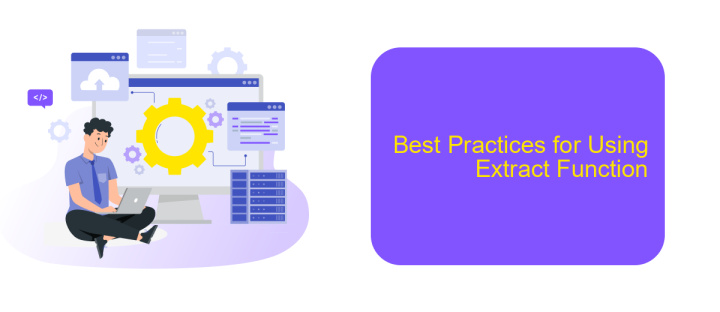Extract Function in ETL Reads Data From
The "Extract Function in ETL Reads Data From" article delves into the critical first step of the ETL (Extract, Transform, Load) process: data extraction. This phase involves retrieving data from diverse sources, ensuring it's ready for transformation and loading. Understanding the nuances of data extraction is essential for optimizing ETL workflows and maintaining data integrity across systems.
Introduction
In the realm of data management, the Extract Function in ETL (Extract, Transform, Load) processes plays a crucial role. ETL systems are designed to handle large volumes of data, extract it from various sources, transform it into a suitable format, and load it into a destination system for analysis and reporting. The extraction phase is particularly vital as it sets the foundation for the subsequent transformations and loading operations.
- Data extraction from diverse sources such as databases, APIs, and flat files.
- Ensuring data quality and consistency during extraction.
- Handling incremental data updates efficiently.
- Integration with modern data platforms and services.
Effective data extraction is essential for accurate and reliable data analysis. Tools like ApiX-Drive can simplify the integration process by automating data extraction from multiple sources, ensuring seamless data flow into your ETL pipeline. By leveraging such services, organizations can enhance their data management capabilities, reduce manual efforts, and ensure data integrity throughout the ETL process.
Benefits of Using Extract Function

The Extract Function in ETL processes offers numerous advantages, significantly enhancing data management and processing efficiency. By isolating and extracting specific data elements from larger datasets, it enables more focused and precise data handling. This not only streamlines the overall ETL workflow but also reduces the risk of errors and inconsistencies, ensuring high-quality data for analysis and reporting. Additionally, the Extract Function facilitates data transformation and loading processes by providing clean and well-organized data sets, which are easier to manipulate and integrate into various systems.
Moreover, leveraging tools like ApiX-Drive can further optimize the extraction process. ApiX-Drive simplifies the integration of various data sources, allowing for seamless data extraction from multiple platforms. With its user-friendly interface and robust automation capabilities, ApiX-Drive enables businesses to set up and manage integrations without extensive coding knowledge. This not only saves time but also ensures that data is consistently and accurately extracted, transformed, and loaded into the desired destinations, enhancing overall operational efficiency and decision-making processes.
How to Use Extract Function

The Extract function in ETL (Extract, Transform, Load) processes is essential for retrieving data from various sources. It simplifies data integration, ensuring that data is accurately and efficiently gathered for further processing. Utilizing the Extract function can significantly enhance the effectiveness of your ETL pipeline.
- Identify the data source: Determine the origin of the data, such as databases, APIs, or flat files.
- Configure the extraction tool: Use tools like ApiX-Drive to set up the extraction process, specifying the data source and the type of data to be extracted.
- Execute the extraction: Run the extraction process, ensuring that the data is accurately retrieved and stored for the next ETL stages.
By following these steps, you can effectively use the Extract function to streamline your data integration efforts. Tools like ApiX-Drive can automate and simplify the extraction process, saving time and reducing errors. Properly extracting data is crucial for maintaining data integrity and ensuring the success of your ETL workflows.
Best Practices for Using Extract Function

When using the extract function in ETL processes, it is crucial to ensure that data is accurately and efficiently retrieved from various sources. Proper extraction lays the foundation for successful data transformation and loading.
First, always validate the data sources to ensure they are reliable and consistent. This involves checking the quality and format of the data before extraction. Additionally, scheduling regular data extraction is essential to keep the data up-to-date and relevant.
- Ensure data source reliability and consistency.
- Schedule regular data extraction processes.
- Use tools like ApiX-Drive for seamless integration and automation.
- Monitor and log extraction processes to identify and resolve issues promptly.
By following these best practices, you can enhance the efficiency and accuracy of your ETL processes. Tools like ApiX-Drive can help automate and streamline data extraction, making it easier to integrate various data sources and maintain data integrity.
- Automate the work of an online store or landing
- Empower through integration
- Don't spend money on programmers and integrators
- Save time by automating routine tasks
Conclusion
In conclusion, the Extract Function in ETL processes plays a critical role in efficiently reading and transferring data from various sources. By optimizing this initial step, organizations can ensure that the subsequent transformation and loading phases are more streamlined and effective. The accuracy and speed of data extraction directly impact the overall performance of the ETL pipeline, making it essential to implement best practices and leverage advanced tools.
One such tool that can significantly enhance the extraction process is ApiX-Drive. This service facilitates seamless integration with multiple data sources, automating the extraction process and reducing manual intervention. By using ApiX-Drive, organizations can not only improve the efficiency of their ETL workflows but also ensure data accuracy and consistency. Ultimately, a well-optimized Extract Function, supported by robust integration services like ApiX-Drive, sets the foundation for successful data management and analytics initiatives.
FAQ
What is the purpose of the Extract function in ETL processes?
What types of data sources can the Extract function handle?
How often should the Extract function be executed?
What are some common challenges faced during the Extract phase?
Can automation tools assist in the Extract function of ETL processes?
Time is the most valuable resource for business today. Almost half of it is wasted on routine tasks. Your employees are constantly forced to perform monotonous tasks that are difficult to classify as important and specialized. You can leave everything as it is by hiring additional employees, or you can automate most of the business processes using the ApiX-Drive online connector to get rid of unnecessary time and money expenses once and for all. The choice is yours!


